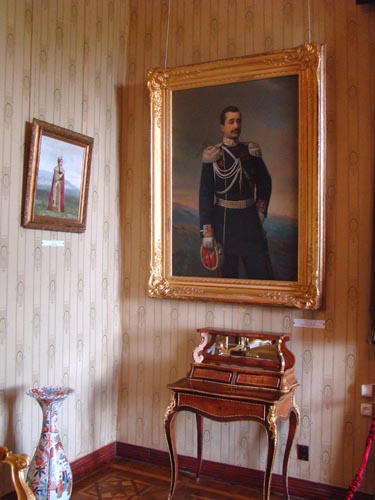
The first attempt to establish a Dadiani Palace Museum in Zugdidi occurred during the brief life of the Georgian Democratic Republic, before the incorporation of Georgia into the Soviet Union. In January 1919, the Parliament of the fledgling Republic passed a law making the state the legal owner of expropriated royal family property. In December of the same year, two members of the constitutional convention inspected the Dadiani Palace (the Queen’s Palace)in Zugdidi to identify items of historic value to ship to Tbilisi. The guardian of the property, housemaster Vladimer Alshibaia, cooperated with the government’s representatives, even showing them a secret vault where the Dadianis stored their treasures during hard times. Items were cataloged, and selected pieces were shipped to Tbilisi.
In February 1920, local leaders in Zugdidi met to discuss the future of the Dadianis’ properties there. They decided that palaces built by the people’s effort should be handed back to the people. However, what this meant in practice was not spelled out, and the decision was not implemented. Later, the more specific idea of converting the Dadiani Palace into a museum was proposed, but the political will and funds to follow through were lacking.
It was not until the Soviet administration of Georgia, which began in 1921, that interest in the use of the Dadiani Palace as a museum surged. In May 1921, as a result of an initiative by the revolutionary committee of the region, the Museum of Samegrelo was opened on the property. The Museum’s first director, A. Chanturia, proved to be a devoted guardian of the Palace and its treasures.
The Museum underwent renovations in 1980s, at which time it was discovered that the walls of the Palace had originally been painted in a 19th century European style quite different from the nondescript paint cover later applied. Unfortunately, multiple re-paintings over the previous decades had rendered the original walls unrecoverable. Today, the original appearance of Palace interior is known only through sketches and photographs.
The collections of the Museum consist of over 45,000 items, some of which date back to the original Palace collection expropriated in 1919, and some of which have been subsequently added. They represent thousands of years of history, and include several utterly unique pieces, such as Napoleon Bonaparte’s death mask and a garment traditionally believed to have been worn by the Virgin Mary. The former came to the Dadiani Palace via Salome Dadiani Murat, who married Napoleon’s nephew Achille Murat. As for the latter, there are many stories about how it might have arrived in Georgia. According to the most popular of these, it was brought there by an archbishop after the fall of Constantinople to the Ottoman Turks in 1453, along with other sacred items. Every year in August, the garment is shown to the public; the rest of the time, it is kept in storage in the so-called Virgin Tower.



Another important part of the collection is the Dadianis’ library, which consists thousands of items—including manuscripts, rare books, and volumes from the private library of Napoleon Bonaparte. In 1927, the Soviet Government wanted to transfer this library to Tbilisi, but Museum Director Chanturia successfully argued that the library was an integral part of the Museum that should remain in the Palace.
The Museum’s armaments collection includes more than 200 swords, pistols, guns, and other military items. Most were gathered as war booty, but some were gifts from Russia’s Tsars. Palace furnishings are of French and Russian design, and many pieces are gilded with gold or elaborately carved.
The Museum owns many other intriguing items collected by the Dadianis. These include the personal effects of Chinese and Japanese imperial families; gifts from Russian, British, and other nobility; and David Dadiani’s personal coin collection, which includes rare coins from ancient Rome and Greece.
The Museum’s collections continued to grow after the property passed to the state. Some of the new collections were artifacts gathered for exhibits to document Soviet life in the region, but Director Chanturia also organized archaeological expeditions that resulted in the acquisition of valuable antiquities. His most important find was made in 1935, when he excavated a site that included the remnants of a house from ancient Colchis; it was set on piles over water, thus seeming to confirm comments made by Hippocrates about the strange lifestyles of the Colchians. Findings from this site were transferred to Dadiani Palace Museum.
After the fall of Soviet Union, the Museum continued to enrich its collections, for example acquiring works of modern art and recovering some previously stolen collection items.
Unfortunately, the Museum’s facilities and collections are generally in poor condition today.
During Soviet times, the Museum often suffered from the neglect or outright hostility of Georgia’s communist leaders. For example, in the early years of the Soviet Union, the Bolsheviks treated the collections as political spoils, and thousands of pieces were “borrowed” by (or presented as “gifts” to) local communist leaders. Some communist leaders disliked the idea of preserving a historical record of the life and times of the hated pre-Soviet aristocracy, and pushed for the Museum to adopt a more ethnographic, or even propagandistic, mission. Partly as a result of such official indifference, the Museum underwent only one, relatively minor renovation during the 70 years of the Soviet era—in the 1980s.
After the fall of Soviet Union, Georgia was engulfed by war and economic crisis, pushing renovation of the Museum far down on the new government’s list of priorities. Happily, some of the collection pieces (including some paintings, the Palace’s ornamental gate, and a few other items) were restored through private efforts. But the basic collections—books, manuscripts, armaments, photos, furniture, paintings—remain badly in need of conservation and restoration, as well as basic research to catalogue the history behind them.